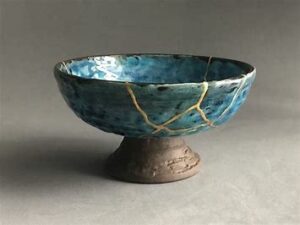Better Than New

Kintsugi is the Japanese art of repairing broken pottery with seams of gold, silver, or platinum. The word Kintsugi actually means “gold joinery.” Sometimes the art is referred to as Kintsukuroi or “golden repair.”
According to tradition, the art dates back to the 15th Century, when a Shogun sent a cherished Chinese tea pot back to China for repair. The pot was returned to the Shogun, but its pieces were reconnected with ugly metal staples. This prompted potters to devise a more aesthetically pleasing method of repairing favorite pottery that had broken.
The method consists of grinding gold, silver, or platinum to dust, then mixing it with lacquer. This gold mix is then used to glue the fragments back together. The appearance of these repaired pots and bowls became very popular. In fact, potters were accused of breaking pots just to cement them together with gold and make them more desirable.

There are several forms that the art of Kintsugi can take. One consists of simply gluing the pieces back together with gold. But when one of the fragmented pieces is missing, the process goes a step further by filling-in that gap completely with gold. If the missing fragment is too large, it may be filled with the fragment of another pot, creating a patchwork of pottery. But gold is always the cement that holds the pieces together.
This art became symbolic to the Japanese people of fixing rather than replacing broken things. It took on the force of a philosophy, that people should embrace imperfections and not try to hide them. And since only the most cherished bowls, dishes, and pots were submitted for repair by this method, people began to value the Kintsugi repair as part of the pottery’s history.
There’s another aspect of Kintsugi that is highly symbolic. After the broken pottery’s repair with so much gold, its value increases immensely. Therefore, both by its added aesthetic appeal and its gold content, the repaired pottery becomes more valuable.
It doesn’t take a philosopher or Bible scholar to see the spiritual applications of this Japanese art. Like a piece of pottery, every human being gets broken with use. It’s inevitable because we are so frail and life is so perilous. Perhaps the brokenness is the result of suffering abuse. Perhaps it’s the result of personal, professional, or moral failure. Maybe the brokenness comes from having our faith dashed to pieces.
And maybe the degree of our brokenness is to the extreme. It’s not just a matter being cracked, so that our usefulness is diminished. Our life has come to an abrupt halt because we’re so fragmented. Or, maybe we’re simply full of fractures because of many failures and bruises. We may still be functional, but just barely.
But God is in the repair business. Better, God is in the redemption and glorification business. When we submit our lives to His loving and capable hands, the result is better than making us like new again. God is an artist of redemption. His repair of our lives makes must far more Christ-like and valuable than ever before.
Moses, David, and Peter were all great men of God. Yet they all failed catastrophically. But after their failure they sought the Lord for forgiveness and redemption. And all of them came through the process far better than they were before.
It’s also significant that, in the Bible, gold is often used to symbolize Deity. Therefore, as those points of the pot’s weakness – where it broke – are repaired with gold, so God replaces our weaknesses with His own strength. And as gold is sometimes used to fill-in what’s missing in the broken pot, so God replaces our deficiencies with His own power and grace. Therefore, it’s not uncommon for God to take our weakest points and make them our strongest. The apostle John is probably one of the greatest examples of this. God took him from being a “son of thunder” (named so because of his anger) and from wanting to call down fire on cities which didn’t open their doors to him, to becoming the “apostle of love.” In his three short epistles speaks of God’s love or commands us to love no fewer than 35 times. God made his weakness his greatest strength.

Now, don’t lose patience during this process, for it’s going to last a lifetime. And there will be moments when, with our imperfect senses, we seem to be getting worse rather than better. We need to trust God at all times during this long and sometimes painful process. Cling to God’s promises of forgiveness, salvation, and eternal security. Cling to Jesus for His grace and for the renewing of your heart and faith. And you will gain the inevitable triumph through Jesus Christ.
PRAYER: Dear Father in heaven, into Your loving and capable hands I place my entire being and life. From the cruelty of others and my own foolish choices I’ve become so shattered that I cannot believe I’ll ever know happiness again. But God I trust in Your power, wisdom, and love to redeem me and ultimately glorify me. Please do this dear Father. Make me better than new. Make me like Your glorious Son, Jesus Christ and prepare me for eternity. In Jesus’ name, Amen.
(Information from: https://en.wikipedia.org/wiki/Kintsugi)







